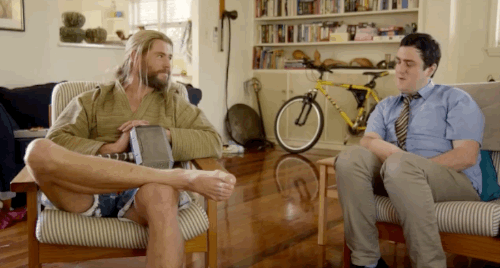Best of the Week: Marvel's 'Thor' Mockumentary, Ben Affleck's Deathstroke Reveal and More
The Important News
DC Extended Universe: Ben Affleck revealed Deathstroke will be the villain in his Batman movie. The Rogues might be the villains in The Flash.
Marvel Cinematic Universe: Marvel is making a New Warriors TV series with Squirrel Girl. Jon Favreau joined Spider-Man: Homecoming as Happy Hogan.
Star Wars: Rogue One: A Star Wars Story will feature an all-black R2-D2 lookalike.
Harry Potter: Daniel Radcliffe is wanted to return for Harry Potter and the Cursed Child.
Transformers: Liam Garrigan will play King Arthur in Transformers: The Last Knight.
Sequels: Zombieland 2 is officially in development. Maze Runner: The Death Cure will resume production in February. Richard Linklater is making a sequel to The Last Detail. Trish Sie will direct PItch Perfect 3.
Festival Buzz: La La Land, Arrival and Nocturnal Animals are getting rave reviews.
Awards: Jackie Chan, Frederick Wiseman, Anne V. Coates and Lynn Stalmaster are this year’s Honorary Oscar winners.
Ways of Seeing: Blazing Saddles and Willy Wonka & the Chococlate Factory are back in theaters this weekend.
Box Office: Don’t Breathe continued the hit streak for horror this year.
Reel TV: The Let the Right One In series is moving forward on TNT. Stranger Things hinted at movies it will reference in Season Two.
R.I.P.: Gene Wilder died at age 83.
The Videos and Geek Stuff

New Movie Trailers: Max Steel, Elle and Shut In.
TV Spots: Blair Witch and Ouija: Origin of Evil.
Clips: Beaty and the Beast and Storks.
Watch: A mockumentary showing what Thor was up to during Captain America: Civil War. And a behind the scenes featurette for Doctor Strange.
See: What Bucky could look like as Captain America. And a fake trailer for a Stan Lee as The Watcher movie.
Watch: A fake teaser for The Batman. And a very weird trailer remix for Justice League.
See: What Joe Manganiello could look like as Deathstroke. And a VFX shot breakdowns for Suicide Squad.
Watch: A VFX breakdown for the Ghostbusters remake.
See: A new Jurassic World museum exhibit coming to America.
Watch: A mashup of Rogue One: A Star Wars Story and The Magnificent Seven.
See: New images from Rogue One: A Star Wars Story. And new images from Woody Allen’s Crisis in Six Scenes series.
Watch: A trailer for Morgan created by an AI. And a Zootopia trailer recut to look like a thriller.
Learn: A secret revealed about John Carpenter’s The Thing.
See: There’s a cookbook inspired by Brad Pitt eating in movies.
Watch: Spike Jonze’s new dance-ilicious short film/ad My Mutant Brain.
See: This week’s best new movie posters.
Watch: Arnold Schwarzenegger’s kid re-create a scene from Terminator 2: Judgment Day.
Our Features
Movie Calendar: See our guide to new movies and anniversaries for September above.
DC Movie Guide: How The Batman can handle Deatstroke and many more villains.
Marvel Movie Guides: What it means for the MCU that Steve Rogers isn’t Captain America. And 5 Spider-Man villains we want to see in the MCU.
Interview: The Russo Brothers on why there’s no Captain America/Black Widow fight in Captain America: Civil War.
In Memoriam: Remembering the reel-important people we lost in August.
Home Viewing: Our guide to everything hitting VOD this week. And our guide to what’s new on Netflix this month.
and
MORE FROM AROUND THE WEB:

.jpg)




